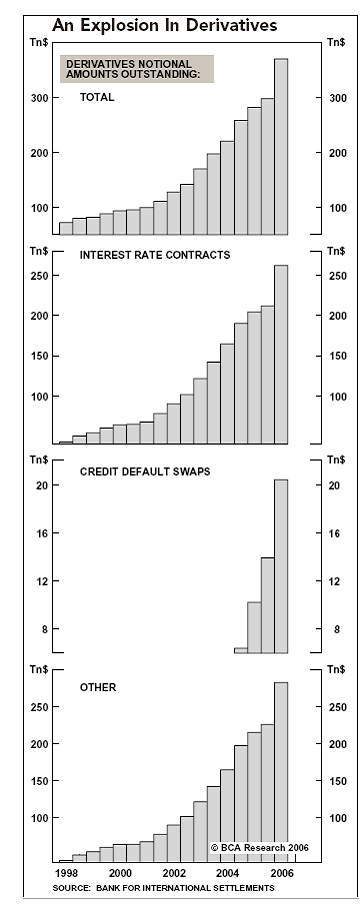

|
| weblog/wEssays archives | home | |
|
Credit Markets: Unregulated and Pathologically Addicted to Lying (September 26, 2007) In keeping with this week's theme, The Rot Within (week II), we've examined the rot within our legal system, Homeowners, Defective Houses and Big Builders: Justice Is Not Blind, and the intellectual hypocrisy/rot within our ruling ideology which claims to support free markets but hurries to feed at the public trough at the first signs of potential loss: Privatizing Profits, Socializing Risk: Hypocrisy and Housing. Today we look at the rot within our financial regulatory agencies. In the past, I have referred to "lightly regulated hedge funds," and frequent contributor Harun I. has observed that hedge funds are regulated, and that the problem lies elsewhere: what isn't regulated are the exotic financial instruments and derivatives which have been sold to unwary investors the world over. How big will the meltdown be when this mountain of leveraged rot collapses? Harun (and other readers as well) recommended this article by Jon Markman:  Are we headed for an epic bear market?
The credit bubble is just starting to unwind, a credit-derivative insider says. And
while U.S. borrowers are being blamed for the mess, they were really just pawns in a
global game.
Are we headed for an epic bear market?
The credit bubble is just starting to unwind, a credit-derivative insider says. And
while U.S. borrowers are being blamed for the mess, they were really just pawns in a
global game.
Harun notes that other financial markets have clear paper trails--but there are no similiar regulations in the markets for credit-market derivatives. Here are his comments: Not much new here but at least the MSM is catching on. At least this is from an insider. The greatest crime of the century has been perpetrated and no one is going to jail. The people who orchestrated this, the government, and the rating agencies all knew the danger of inverted pyramiding of leveraged bets; one small adverse move wipes you out. (emphasis added: CHS) It is not that the hedge funds were unregulated--it is that these new innovations don't fall under SEC or CFTC purview.As many of you have read, the fundamental lie at the heart of the credit market is "mark-to-model," a fancy way of saying the security is not priced by what someone will actually pay for the security in the real world, i.e. mark-to-market. As a result, securities which are worth 10 cents on the dollar in the real marketplace are kept on the books as worth a dollar--a fiction which is allowed because regulators have dozed at the wheel, happily enabling a global fraud of inimaginable proportions. As Harun observes, the regulators and insiders all knew the pyramiding of risk and leveraging of cash into 20-to-1 or even 100-to-1 "bets" (buying $100 of pyramided derivatives with only $1 cash on the line) was risky--yet the game was allowed to run because the fees and profits being generated by investment banking houses and other players were truly gargantuan. And of course some of these outsized gains made their way to politicos, who were pleased to rely on "market forces" to guide this ponzi scheme of leverage and deceptively priced securities. Simply put: there was no reason these markets couldn't have been regulated by the same agencies which regulate stock market derivatives (options) and futures contracts. If every CDO and MBS (mortgage-backed security) had been required to be marked to market at the end of every trading day, then the Big Lie (these are worth X when in fact they're only worth Y) could not have been perpetuated. And if reasonable margin requirements (cash supporting the bet) had been enforced as they are for stock and futures bets/instruments, then the truly insane growth of these credit derivatives would have been limited by the players' cash. Recall that regulations require any stock purchased on margin to be backed by 50% cash. Simply using the same margin requirements for credit derivatives and securities would have imposed some common sense on a market which remains pathologically addicted to lying to survive. Thank you, John and Cindy B., ($25) for your generous third donation via check to this humble site. I am greatly honored by your continuing encouragement and readership. All contributors are listed below in acknowledgement of my gratitude. For more on this subject and a wide array of other topics, please visit my weblog. copyright © 2007 Charles Hugh Smith. All rights reserved in all media. I would be honored if you linked this wEssay to your site, or printed a copy for your own use. |
||
| weblog/wEssays | home |